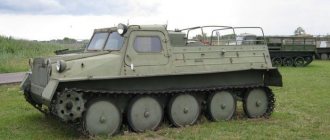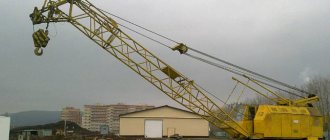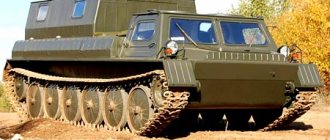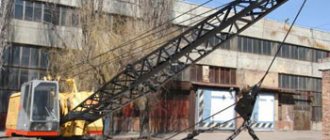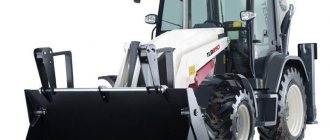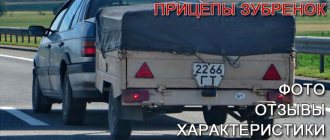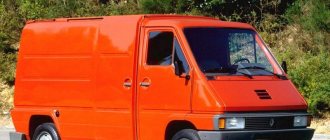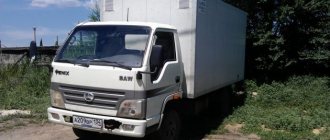Description
The GT-SM transporter is a floating snow and swamp tracked vehicle with a carrying capacity of 1 ton and is designed for transporting personnel, various cargo, towing trailers (weighing up to 2000 kg), evacuating the wounded and for other needs of troops in the northern regions of the country, as well as for transporting people and national economic cargo.
The conveyor can be used on all types of roads and off-road with the ability to overcome water obstacles. The conveyor is designed for operation and non-garage storage at ambient temperatures from +40 to −50 °C. The machine was and is widely used in the Far North.
Design and manufacturing
Gas-71: technical characteristics and applications
Sarin has a stereocenter on the phosphorus atom, so there are two enantiomers: one has ( R
) configuration and the other is (
S
) configuration.
The manufacturing processes described here produce racemic sarin, that is, a 1:1 mixture of ( R
)-methylfluorophosphonic acid isopropyl ester and (
S
)-methylfluorophosphonic acid isopropyl ester.
Under the influence of methyl iodide ( 2
) is removed from the phosphorous acid ester (
1
()
diisopropyl fluorophosphite
) in phosphonate synthesis, isopropyl fluoromethylphosphonic acid sarin (
3
) (+ 2-iodopropane (
4
)) is obtained:
The American method of producing sarin is based on the use of dimethylmethylphosphonate ( 1
).
This is converted with thionyl chloride to acid methylphosphonic dichloride ( 2
), which after fluorination with hydrofluoric acid reacts to methylphosphonic acid difluoride (
3
):
Finally, methylphosphonic acid difluoride can be converted to sarin by adding isopropanol:
When used in binary warheads, the last reaction above is used in that methylphosphonic acid difluoride and isopropanol react with sarin after the grenade is fired - using a reaction accelerator; the final product is formed in 10 seconds with a yield of 70%.
Modifications of GAZ 71
Technical characteristics of the car gas 33023 2.9 (2003). technical characteristics gas 33021
This model has become the basis for further development, improving its best qualities and capabilities. For this purpose, several modifications were developed that had certain advantages and were all aimed at increasing the reliability and autonomy of the all-terrain vehicle.
GAZ 3403 represents the next generation of all-terrain vehicles. What are the improvements?
- The volume of fuel tanks became 93 liters.
- Now all the torsion bars have been sealed. For Gas 71 this only affected the front and rear pipes.
- They began to use more wear-resistant brake bands.
- Variability of awnings and bodies. Namely:
- body with a simple awning;
- a body with sleeping places for four people (previously it was for two) and a double awning. This option is called northern;
- The body is high, rigid, there is a large door, there are also four sleeping places.
This model already had its own variants:
- GAZ 34032. The vehicle is designed to perform search and rescue of people. The platform is located at the rear to allow cargo to be taken on the water.
- GAZ 34033. It was developed for use by the border service. An additional generator (two in total) and a battery (two groups in total) were installed.
- GAZ 34034. Diesel D-247 (atmospheric) was installed. Diesel fuel costs in difficult conditions have dropped to one liter per kilometer.
- GAZ 34036(37). A D-247 diesel engine and an additional rear roller, nicknamed the “sloth”, were used, which added 0.6 m of cargo space. The all-terrain vehicle's swimming capabilities have increased. GAZ 34036 uses two awnings, GAZ 34037 - one.
All these all-terrain vehicles received the GAZ 66 gearbox.
GAZ-34039. This modification is being produced now - equipped with an autonomous body heater, a D-245 diesel engine with turbocharging, a GAZ 33104 clutch and gearbox. The load capacity has increased to 1.5 tons.
The GTMU armored personnel carrier was developed specifically for use in the military sphere. It is used in the so-called minimum size army. This car maneuvers well. It is a lightly armored airborne model. True, the tracks wear out quickly under heavy weight. The vehicle is 10 cm smaller in width, there is no armor on the bottom, and the GTMU is lower than other all-terrain vehicles.
There are also modifications used in the military sphere. They are used to pull out (rescue) the wounded, for chemical reconnaissance, and as an artillery tractor.
The GAZ 71 tracked all-terrain vehicle is a machine that has proven itself in difficult situations and conditions and is still used today.
GAZ 71 diesel has decent technical characteristics. It was the basis for the development of many modifications that are actively used today in the military sphere and beyond.
Repair of gas main gear 71 • Design and purpose
| GAZ 71: where to buy an all-terrain vehicle and its characteristics There is practically no need to worry that the car will cross a calm river, however, you should be careful when crossing water obstacles with fast currents. The instrument panel consists of a free-standing speedometer and a rectangular console on which additional instruments, switches and indicator lamps are installed. |
| Soviet all-terrain vehicles GAZ-71, GT-SM; Gazushka; a real minibus for the North | Life on the move | Pulse Butusov developed a project for an all-wheel drive all-terrain vehicle-swamp vehicle GAZ-62B with a lifting capacity of 1.2 tons with independent suspension and all single-pitch drive wheels. In addition, diesel D-247 differs only in the number of revolutions from the mass-produced tractor diesel D-243 Belarus-MTZ-80 and is incomparably more reliable than the gasoline ZMZ-53 66. |
- GAZ-34032
- search and rescue with a platform at the rear for receiving cargo afloat, - GAZ-34033
- for the border service with two generators, two groups of batteries, medical, repair with a welding generator. - GAZ-34034
- installation of an atmospheric diesel engine D-247 in the same body. - GAZ-34036/34037
(tent2/tent1) - version with D-247 diesel engine and additional rear roller. The buoyancy of the hull has increased.
»Technical
• 2 Number of seats in the landing body, persons. » icon=»icon: thumbs-o-up» icon_color=»#DD3333″]
Crawler all-terrain vehicle GAZ 71: operation, characteristics
Zil-135lm: technical characteristics
The 60s were marked by the beginning of the development of territories hitherto unexplored, such as Siberia, the Far North, and the Far East. It was necessary to develop promising industries - the gas and oil industries. For their research, a new vehicle was needed that could overcome any difficult terrain in difficult climatic conditions. Otherwise, it must move well on any roads, off-road, water, snow and snowdrifts, swamps, deserts, while working efficiently at high humidity and low temperatures. To this end, the Zavolzhsky Crawler Tractor Plant is starting to produce a new vehicle - the GAZ all-terrain vehicle. The time of its release is 1968-1985. The basis for the development of GAZ 71 was another model - GAZ 47. The developers used all the best of this all-terrain vehicle.
Machine history
In the 60s, when the Soviet economy had noticeably recovered from the horrific consequences of the war, the USSR government thought about creating a new car capable of overcoming any off-road conditions. The car was planned to be used to explore Siberia, the Far East and other unexplored areas for the development of the oil and gas industries.
The new car was required to be able to move not only off-road, but also to sail on water. Transport had to withstand harsh climatic conditions (high humidity and extremely low temperatures).
From 1954 to 1964, the Gorky Automobile Plant produced the GAZ-47 all-terrain vehicle, widely used in various industries and valued for its high cross-country ability. However, in the 60s it became obvious that the old all-terrain vehicle did not meet modern requirements. Engineers began to develop a new model based on the old one, taking all its successful properties from it.
A problem was encountered already at the production stage: the Gorky enterprise could not produce a sufficient number of cars to meet the needs of the entire state. In 1973, the all-terrain vehicle assembly line was completely transferred to the specialized Zavolzhsky Tracked Tractor Plant (ZZGT).
Sale of GAZ-73 (GTMU) Gazushka
Years of production of GAZ-73: 1985,1987,1991 Mileage: 300-1000 km Condition: excellent (preserved) Complete set: complete Price: 1,800,000 rubles
To buy a GAZ-73, send a request from the website or by email. The current offer will be provided upon the availability of GTMU tractors for sale at storage sites.
Purpose of GAZ-73 (GT-MU)
The specialized all-terrain vehicle GAZ-73 was used for landing personnel, including air landing.
In civilian use - “Gazushka”, the all-terrain vehicle GTMU has established itself as an unpretentious vehicle that copes well with overcoming any off-road conditions. It reaches a speed of 55 km/h on land and 6 km/h on water.
Description and characteristics
The multi-purpose transporter-tractor (tracked lightly armored airborne armored personnel carrier) GT-MU (GAZ-73) was developed in 1970 by specialists of the Gorky Automobile Plant. In 1973, testing of the first samples began, and a year later serial production started at the Zavolzhsky Tracked Tractor Plant (ZZGT). Tractors were supplied to various troops and medical units for transporting the wounded, including airborne brigades. Note that these vehicles were used by the Soviet army during military operations in Afghanistan and were in demand until the mid-80s of the last century. In 1985, ZGT stopped producing them. Its progenitor was the GT-S (GAZ-47) tracked transporter, whose layout with a number of improvements became the basis for the new vehicle.
Based on the GAZ-73, several types of special vehicles were developed: RKhM-2 and RKhM-2S (chemical and bacteriological reconnaissance vehicles), as well as SPR-1 (jamming station). Modifications of the GT-MU were all-terrain vehicles used as surveyors and radio jamming stations at border outposts. Other modifications include an amphibious assault vehicle with a capacity of up to ten people, a command post vehicle and a chemical reconnaissance vehicle.
GT-MU (GAZ-73) is a fairly maneuverable vehicle, and also has very high cross-country ability - it can easily overcome off-road conditions and water obstacles. It is universal for transporting passengers, transporting cargo and towing trailers.
The sealed body of the GT-MU (GAZ-73) tractor is made of steel sheets. It contains hatches and loopholes. An engine with a power of 115 hp is installed in the middle part of the all-terrain vehicle. A special tracked propulsion unit (tracked platform), having a large area of contact with the ground, minimizes pressure, which allows the vehicle to easily move through swampy terrain and through water obstacles up to one and a half thousand meters wide. Moreover, the weight of the all-terrain vehicle is almost five tons, moreover, it can take another ton of cargo on board, and in such conditions it can “swim” at speeds of up to 6 km/h. Note that the climb the all-terrain vehicle can overcome on dry, hard ground with a full load is 35 degrees. On the highway, the tractor can move at speeds of up to 60 km/h.
Thanks to its unique properties, the GT-MU all-terrain vehicle can be used in various areas of the national economy. It is especially convenient in off-road conditions, which has earned it popularity in the Far East and Siberia.
General description of the design of the GAZ-71 all-terrain vehicle
The body of the all-terrain vehicle is made of steel sheets of different thicknesses, connected by welding. It is completely sealed, which allows the car to float and ford water obstacles. Despite its rather impressive size, the GAZ-71 has high maneuverability and good speed.
The machine body can be divided into three sections:
- cabin;
- power compartment;
- cargo platform.
The engine is separated from the cargo platform and the cabin by special steel partitions, the panels of which can be removed. This makes access to the power plant components easier. There is also a pump installed in the engine compartment, the task of which is to pump out water while the all-terrain vehicle overcomes various water obstacles.
In the cockpit of the GAZ-71
The all-metal cabin contains two seats - for the passenger and the driver of the all-terrain vehicle. It has two side doors and two hatches that are located in the roof. The doors have special rubber seals that protect the cabin from water and dust. The battery is located behind the driver's back.
The cargo platform is covered with an awning, the frame of which is metal arches. The rear side of the platform is folding; folding seats are located on its sides. A liquid heater is used to heat the cargo compartment.
Modifications
The GAZ-34039-32 version is designed to transport 8 seated passengers and is equipped with a body covered by a tent with a loading height reduced to 920 mm. The compartment allows the transportation of cargo weighing up to 1100 kg. The standard equipment includes a folding table located in the front part of the body. Additionally, an independent air heater of the Webasto type is installed, providing comfortable conditions in the cabin. The chassis is equipped with tracks with rubber-metal hinges.
To transport goods, a simplified GAZ-34039-22 vehicle is used, equipped with a cargo platform, which is covered with a tarpaulin awning. The compartment is equipped with a removable grating made of wood. There are 2 folding seats of a semi-soft design, which are designed for transporting accompanying personnel. Tracks with rubber elements in the hinges are used. A modification of the truck with standard steel tracks was designated 34039-23.
An improved model is being produced, equipped with 12 passenger seats, which can be transformed into 4 sleeping places. The car's interior is equipped with a hinged hatch that improves ventilation in the summer. The vehicle received the designation GAZ-34039 Irbis and is equipped with caterpillar tracks with rubber-metal compounds, providing an increased service life. From the outside, the body and windshield are protected by additional arches made of steel profiles.
The driver's cabin received an instrument panel from a Gazelle truck. The seat is adjustable in several directions; the standard steering column is used to change the direction of movement. The power unit was moved to the cabin, which simplified the maintenance procedure. The windshield and body elements are identical to those used on Gazelle buses.
The GAZ-34039-33 modification is equipped with an open platform that allows you to mount a special insulated awning. The floor of the cargo compartment is made of multi-layer plywood, which is an additional heat insulator. Inside there are folding seats for 2 people, above which there are places for rest and sleep. The compartment is heated by supplying hot air from an autonomous electric flare unit connected to the on-board network.
Specifications
- Max. weight in working order (with refueling, without cargo and crew), kg: 3750
- Max. weight of cargo transported in the body, kg: 1000
- Max. towed trailer weight, kg: 2000
- Gross weight with load and crew of 2 people, kg: 4300 - 4950 (5300)
- Crew, people: 2
- Number of seats in the body (troops, people): 10
- Number of beds: 2
- engine: GAZ-71 (ZMZ-66), gasoline, carburetor
- engine power, l/s: 115
- 4-speed gearbox with transfer case - from GAZ-66
- Fuel is gasoline A-76, for A-93 an octane corrector adjustment on the engine is required
- Maximum torque, kgf m: 29
- Specific power in l. With. /t: 23.1
- Overall dimensions, m: length - 5.39
- width - 2.582 (2.585)
- cabin height - 1.74 (1.72)
- on the highway - 50
- on the highway - 100-150
Development [edit | edit code]
Further development was a number of options in various combinations. All these modifications to the base GAZ-71 increased the reliability and autonomy of the vehicle, but at the same time its weight increased to 5.3 tons and the specific ground pressure increased from 0.17 to 0.21.
GAZ-3403 [edit | edit code ]
Load capacity 1250 kg. All torsion bars are “thick” (on the GAZ-71 - only in the front and rear pipes). Double windshields. Fuel tanks were increased from 75 to 93 liters, brake bands on the main gear were replaced with more wear-resistant ones.
External differences from the GAZ-71: beveled casings of 93-liter tanks, glass side doors on overhead bolted frames, a power steering cover with internal locks, sprocket rings - 13-tooth, on bolts, not rivets.
They were produced with different body awnings:
Options were also produced with a caterpillar track with a rubber-metal joint and with an autonomous heater in the body.
- GAZ-34032
- search and rescue with a platform at the rear for receiving cargo afloat, - GAZ-34033
- for the border service with two generators, two groups of batteries, medical, repair with a welding generator. - GAZ-34034
- installation of an atmospheric diesel engine D-247 in the same body. - GAZ-34036/34037
(tent2/tent1) - version with D-247 diesel engine and additional rear roller. The buoyancy of the hull has increased.
All these cars have a gearbox (together with a transfer case) from a GAZ-66 car.
Since the speed of the D-247 diesel engine is less than the gasoline ZMZ-66, on diesel cars, in order to achieve the same maximum speed, the gear ratios in the final drive and gearbox transfer case were changed. The sprocket now has 13 teeth instead of 12, the rims are more powerful, on bolts rather than rivets, the sprocket itself is attached to the side shaft not with a nut, but with three bolts through a powerful washer.
GAZ-34039 [edit | edit code ]
GAZ-34039 is a currently produced all-terrain vehicle with a D-245 diesel engine with turbocharging, like the ZIL-5301 “Bychok”. Power has increased. 5-speed gearbox and new main gear in a block with a transfer case. An autonomous body heater is installed instead of the right front tank. Clutch and gearbox from GAZ-33104 Valdai. The visual difference from the GAZ-34037 is that the air intake “mushroom” has been moved to the left side.
Load capacity - 1500 kg.
GT-MU [edit | edit code ]
GT-MU is a lightly armored tracked airborne armored personnel carrier for an army of minimal dimensions. A very maneuverable vehicle with a rigid, tenacious hull, but high wear on the tracks due to the weight. The armor is about 6 mm thick upwards from the tank casings, the side behind the track is 4 mm (the bottom is not armored - like on a regular all-terrain vehicle), a filter-ventilation unit, loopholes, triplexes. The car is slightly lower, the length is about 0.7 meters shorter, 5 rollers instead of 6, as on the GAZ-47, and the same arrangement of balancers (paired balancer pipes, as on the GTT and GAZ-47), 93-liter tanks. All units are from GAZ-71, only torsion bars are from GAZ-47, respectively, the width of the car is 100 mm less. Specific pressure 0.24.
- GT-MU
- GAZ-3402
- GT-MU-1 (with diesel)
- GAZ-3402D (with a supercharged diesel engine D-245 and an additional roller).
Known modifications: ambulance with a winch for pulling out the wounded, chemical reconnaissance, artillery tractor, electronic warfare vehicle.
GAZ-71 is an all-terrain vehicle that was used in the Soviet Union for military purposes, as well as for exploring inaccessible areas of Siberia. GAZ-71 replaced the 47th model of the Gorky all-terrain vehicle, which by that time was morally outdated.
Transmission
Some technical data of the conveyor:
- The gearbox is four-speed, manual, synchronizers are in third and fourth gear, reverse gear is with a reduced gear ratio;
- transfer case of a two-shaft type, with two gears;
- main gear - bevel gears in an aluminum housing;
- cardan drive - shaft on needle bearings;
- dry clutches, multi-disc, 10 driving, 9 driven;
- copper-asbestos band brake mechanisms, drum diameter - 294 mm, pressure band width - 120 mm;
- Onboard transmissions are single-stage, with a cylindrical gear.
All-terrain vehicle characteristics
GAZ 71 diesel has technical characteristics that distinguish it favorably from the previous GAZ 47 model. Let's consider the main ones.
The GAZ 71 engine has 8 cylinders. It runs on gasoline. It is a strong carburetor with a capacity of 115 horsepower. Volume – 4.25 l. The engine is part of a single system. It is built into the engine compartment. It also includes a gearbox, a single-plate dry clutch and an additional gear. The gearbox is mechanical, four-speed. It has five speeds - four forward and four reverse. The transfer case has two gears, inherited from the GAZ 66. The device also includes final drives and a double band brake system.
The chassis consists of the following components:
- support rollers. There are 12 of them in total;
- tracks covered with rubber. There are 6 of them on each side;
- driving wheels (2 pieces).
Hydraulic shock absorbers are installed on the rear guides and front rollers.
When moving in snowy areas, special removable snow blowers are installed on the tracks. They prevent ice from forming and prevent snow from sticking.
The body is an open steel heated cargo platform. In bad weather, you can additionally pull the awning to create a thermal and protective effect when transporting people. The all-terrain vehicle is designed for 12 seats. Two seats for the crew in a metal cabin and 10 seats with soft folding seats in the body for troops carrying people. For cases of transporting the wounded, the body is equipped with the necessary sanitary equipment.
The tightness of the cabin is ensured by a rubber seal along the edges of the doors. This is a guarantee of protection against dust and water. For air ventilation in the cabin there are two sealed hatches. It also provides thermal insulation, a heater, soft seats, and soundproofing. In general, the equipment of the all-terrain vehicle creates optimal comfort for people while driving. Behind the driver's seat, in “manual accessibility”, there is a battery hidden behind a metal plate. It can be easily removed, which is very convenient.
Body and cabin structure
The cargo platform of the car is made of steel. To transport people in low temperature conditions, a body heating system and the ability to install an awning are provided. The awning is mounted on the frame, ventilation is provided by a special sleeve. The back contains sanitary equipment for evacuating wounded people. The platform is designed for 10 passengers; for their comfort there are folding semi-soft seats.
The cabin is made using all-metal technology. It has two doors and seats two people - a passenger and a driver. The cabin is sealed at a high level - after overcoming water obstacles up to 1.2 meters deep, the cabin remains completely dry. Ventilation is provided by two hatches in the roof of the compartment. Thermal and sound insulation of the cabin is well done. To maintain a comfortable temperature, a heating mechanism is installed. The battery is located behind the driver's seat, covered by a metal plate that can be easily removed.
GAZ 34039-0000023 (with OSh tracks*)
| Equipment: cargo-passenger, engine. D245, OSH tracks, the body is equipped with folding semi-soft seats, number of seats 12 (10+2), awning, autonomous engine heater PZHB-18, headlight finder | Values |
| Weight of the equipped snow and swamp-going vehicle (without cargo and crew) kg. | 4500 |
| Load capacity, kg. | 1500 |
| Permissible total weight of the towed trailer, kg. | 2000 |
| Number of seats in the cabin | 2 |
| in the back | 10 |
| Average specific ground pressure, kPa (kgf/cm2) | 21,4 (0,214) |
| Engine D245.12S diesel, in-line 4-cylinder with turbocharging: | |
| power, kW (hp) gross | 80 (108,8) |
| maximum torque, N*m (kgf*m) | 353 (36,0) |
| Engine displacement, cm3 | 4750 |
| Gearbox (Gearbox), type | mechanical |
| Number of gears, units, not less | 5 |
| Main gear of the gearbox, parameters | in a monoblock with additional gear |
| Steering controls | levers |
| Guide wheel (suspended sloth roller) | Availability |
| Maximum speed, km/h | |
| along the highway | 60 |
| afloat | 5-6 |
| Overall dimensions, mm.: | |
| width | 2550 |
| length | 5720 |
| height | 2000 |
| Internal dimensions of the body, mm: | |
| width | 1678 |
| length | 2706 |
| height | 1440 |
| Maximum technically permissible weight, kg. | 6000 |
| Maximum design speed, km/h | 60 |
| Track, mm. | 2150 |
| Base, mm. | 3600 |
| Ground clearance, with full load mm, not less | 400 |
| Forged track width, mm | 390 |
| Number of road wheels, pcs. | 6 |
| The location of the drive wheels | front |
| Overcome angle of ascent, degrees | 35 |
| Average fuel consumption | from 45 l/100km |
| Fuel range on the highway, km. | 900 |
| On-board voltage, V | 24 |
| Driver's cab design | Separate, isolated from the engine and cargo compartment, a double cabin, two doors located on the right and left sides, two hatches on the cabin roof above the driver and passenger seats. |
| Engine compartment design | Isolated from other compartments, located in the middle part of the all-terrain vehicle between the cabin and the cargo compartment. |
| Cargo compartment design | Isolated from the cabin and engine compartment, with an awning. |
| Number and location of fuel tanks | 4 pcs., placed in niches, on the right and left sides of the body, outside. |
| Body color | green |
| Requirements for PSM | Availability in the PSM of a mark on payment of the Utilization fee |
*OSH – open joint, track resource 6,000 km.
Refill tanks
Consumable data on components and assemblies:
- main gasoline tanks with a total volume of 232.5 liters;
- reserve tank - 77.5 liters;
- cooling system - 30 liters;
- engine lubrication system - 9.5 liters;
- air filter oil bath - 0.55;
- gearbox housing volume - 3 liters;
- final drive housing volume - 3 liters;
- volume of final drive housings - 2.6 liters;
- roller hubs - 0.16 liters each;
- fan gear housing volume - 0.11 liters;
- The capacity of the clutch hydraulic system is 0.45 liters.
Main controls:
- rotary functions - alternate activation of side clutches and brakes on the drive rollers;
- activation of the mountain brake - clamps on the levers;
- gear shifting - floor lever;
- transfer case gear shift - floor lever;
- Clutch operation is a pedal on the left, equipped with a hydraulic drive.
Chassis parameters:
- drive wheel axle height - 620 mm;
- height of the towing unit axis - 620 mm;
- cargo compartment height - 1130 mm;
- maximum speed on the highway - 50 km/h;
- maximum speed on water - 6 km/h
Electrical appliances and mechanisms:
- mains voltage - 12 volts;
- generator brand G130-E1 DC, shunt, shielded, 28 amperes;
- battery - type 6-ST-68-EMZ;
- relay-regulator - type PP-129;
- ignition distributor - type P105 with centrifugal ignition timing adjustment and octane number corrector;
- standard two-blade windshield wiper;
- starter - type ST130-B, push-button activation.
Operation and applications
GAZ 71 has another name - GTSM all-terrain vehicle. Otherwise, we are talking about a medium modernized caterpillar conveyor (snow and swamp-going vehicle). The word “average” means that the load of the fuel and transport equipment is one ton. The ability to move through water allowed it to be called a waterfowl. Despite the fact that this model was developed back in the 60s, it is in great demand to this day. This vehicle is distinguished by special technical characteristics, simplicity of design, economical maintenance, the best qualities of an all-terrain vehicle (overcoming obstacles, high maneuverability in any conditions, endurance), availability and prevalence of spare parts. Photo GAZ 71:
Over many years of its operation in the national economy and military sphere, the GAZ tracked all-terrain vehicle has completed many important tasks. For this he earned a good reputation among drivers of this transport.
Areas of application of the GAZ 71 all-terrain vehicle:
- geological exploration;
- energy;
- oil and gas industry;
- military sphere.
This miracle technology is also used by private individuals - hunters, fishermen, travelers.
- delivery of people and various cargoes to various remote areas of the country under difficult conditions;
- transportation of soldiers, evacuation of the wounded;
- support for scientific expeditions, primarily geological exploration;
- transportation of trailers weighing up to two tons.
The temperature range for using GAZ 71 was 90 degrees – from –50° to +40° Celsius. You don't need a garage to store your car, even at these temperatures. The all-terrain vehicle is absolutely self-sufficient, as it is equipped with special means for self-extrication if it gets stuck.
Its swimming capabilities are impressive. It is capable of crossing a ford (depth 1.2 meters), a wide river area (1.5 km) at a speed of 6 km/hour. The swimming function of the all-terrain vehicle is provided by the rotation of the tracks. And the final drive makes them move. Externally, the GAZ tracked all-terrain vehicle may seem awkward due to its large dimensions. But this is appearance. In practice it is quite flexible. Increased speed and ability to maneuver on water are provided by special hydrodynamic casings that can be quickly removed
When crossing a body of water, an important condition must be taken into account: you can only cross a calm river
It is better not to use a snow and swamp-going vehicle on a river with a fast current - it can spin and even flood. The reason is that the underwater surface has a large area.
The speed of the special vehicle depends on the quality of the roads and terrain. The GAZ 71 all-terrain vehicle on a more or less flat road reaches speeds of up to 50 km/h. When moving in a swamp, the speed is reduced to 18 km/h, in difficult conditions - to 12 km/h. In snowy areas where the snow is 1 meter deep, it can only reach a speed of 17 km/h.
At the same time, fuel consumption is not entirely economical. When the maximum speed develops, the all-terrain vehicle moves off-road, 150 liters per 100 km are consumed. The average consumption is not much less - 100 to 100, respectively. To ensure enough fuel for 400-500 km, during development, four fuel tanks were placed on the sides of the car: three of them with a volume of 232.5 liters each, in addition to them a tank of 77.5 liters.
Application of an all-terrain vehicle
The first prototype of a new generation tracked vehicle was assembled in 1968. The model was called GT-SM. Over 17 years of production, the 71st version completed a huge number of economic and military tasks. The consumer appreciated this car for its technical characteristics and high cross-country ability.
Some GAZ-71s have survived to this day and continue to be in regular service. They are used mainly in the North. The long service life of the machine is due to its simple design, inexpensive maintenance and the availability of spare parts.
The all-terrain vehicle delivers people and cargo of various categories to hard-to-reach corners of the country, overcoming off-road conditions, water obstacles and low temperatures. In the military industry, the GAZ-71 was used to transport soldiers and ammunition, support scientific expeditions, evacuate the wounded, and so on. The 71st is capable of towing trailers weighing up to 2 thousand kilograms.
Off-road driving is complemented by a self-extrication function in case of getting stuck. The all-terrain vehicle can move through snowdrifts, deserts, swamps and swim on water. The maximum duration of the swim is one and a half kilometers; due to the rotation of the tracks, the GAZ-71 can reach speeds of up to 6 km/h.
For swimming, the installation of quick-release hydrodynamic casings is required. The car can exit the water at an inclination of no more than 20 degrees. Experts recommend using vehicles on calm rivers; fast currents can flood a car.
Application
Civilian transporters GAZ-71 are widely used in the Far North and Far East, where they make up a significant share of the fleet of all-terrain vehicles and tractors. The machine is used for delivery and supply of geological parties. Mobile drilling rigs were installed on the GAZ-71 base with equipment located on the front or rear of the hull.
An interesting modification of the machine is the installation for ice fishing (PT-ILT). In addition, on the basis of the GAZ-71, fire engines VPL-149A, short-circuit stations SKS-1A-02 and a number of other equipment were produced.
GAZ-71 all-terrain vehicles were used in the army to deliver personnel, small arms and mortars, and ammunition. The vehicle is designed to transport 10 people. The cargo compartment of the transporter can be used to transport the wounded on stretchers.
By order of the KGB border troops, border variants were produced under the designation GMP and GMP-1.
The equipment included night vision devices and various radio equipment. The roof of the driver's cabin was equipped with machine gun mounting points. A search and rescue version of the GT-PS was produced for the military space forces.
Based on the GAZ-71, the GT-MU airborne armored personnel carrier was developed. The upper part of the vehicle was protected by armor 4-6 mm thick; the bottom was made of ordinary steel sheet. The chassis has been shortened by one roller to reduce dimensions and reduce weight. The armored personnel carrier could be equipped with gasoline or diesel power units.
GAZ-3402D vehicles are equipped with a chassis identical to the GAZ-71. On the meringue GT-MU there were sanitary versions equipped with a cable winch for evacuating stretchers with the wounded. Combat vehicles could be used as artillery tractors or chemical reconnaissance vehicles.
Army modification
The armored tracked all-terrain vehicle (armor thickness - 6 mm) GAZ-71 is airborne, mobile, highly maneuverable, has minimal dimensions, and is ideally suited for use in military conditions. The conveyor has only one relative disadvantage: its tracks wear out quickly, and individual tracks have to be replaced. Otherwise, the car is considered technically advanced; GAZ-71 spare parts are not often required.
The cabin has two seats - for the driver and the officer accompanying the vehicle. The body can accommodate 10 personnel.
The transporter body is not armored underneath and is quite vulnerable, but the vehicle was not created for offensive combat operations, but only as a reliable cargo carrier in off-road conditions.
GAZ 34039-0000033 (with OSh tracks*)
| Equipment: passenger, engine. D245, autonomous engine heater PZHB-18, autonomous passenger compartment heater Pramotronik 4D-24, number of seats 10 (2+8), incl. sleeping -4, metal. body, headlight finder | Values |
| Weight of the equipped snow and swamp-going vehicle (without cargo and crew) kg. | 4900 |
| Load capacity, kg. | 1100 |
| Permissible total weight of the towed trailer, kg. | 2000 |
| Number of seats in the cabin | 2 |
| in the back (including sleeping ones) | 8 (4) |
| Average specific ground pressure, kPa (kgf/cm2) | 21,4 (0,214) |
| Engine D245.12S diesel, in-line 4-cylinder with turbocharging: | |
| power, kW (hp) gross | 80 (108,8) |
| maximum torque, N*m (kgf*m) | 353 (36,0) |
| Engine displacement, cm3 | 4750 |
| Gearbox (Gearbox), type | mechanical |
| Number of gears, units, not less | 5 |
| Main gear of the gearbox, parameters | in a monoblock with additional gear |
| Steering controls | levers |
| Guide wheel (suspended sloth roller) | Availability |
| Maximum speed, km/h | |
| along the highway | 60 |
| afloat | 5-6 |
| Overall dimensions, mm.: | |
| width | 2550 |
| length | 5720 |
| height | 2175 |
| Internal dimensions of the body, mm: | |
| length | 2706 |
| width | 1678 |
| height | 1600 |
| Maximum technically permissible weight, kg. | 6000 |
| Maximum design speed, km/h | 60 |
| Track, mm. | 2150 |
| Base, mm. | 3600 |
| Ground clearance, with full load mm, not less | 400 |
| Forged track width, mm | 390 |
| Number of road wheels, pcs. | 6 |
| The location of the drive wheels | front |
| Overcome angle of ascent, degrees | 35 |
| Average fuel consumption | from 45 l/100km |
| Fuel range on the highway, km. | 900 |
| On-board voltage, V | 24 |
| Driver's cab design | Separate, isolated from the engine and passenger compartment, a two-seater cabin, two doors on the right and left sides. Two hatches on the cab roof above the driver and passenger seats. |
| Engine compartment design | The engine compartment, isolated from other compartments, is located in the middle part of the all-terrain vehicle between the cabin and the passenger compartment. |
| Design of the passenger compartment. | A metal passenger compartment isolated from the cabin and engine compartment, a hatch on the roof of the compartment, a folding table in the passenger compartment, an entrance door in the rear wall of the passenger compartment |
| Number and location of fuel tanks | 4 pcs., placed in niches, on the right and left sides of the body, outside. |
| Body color | green |
| Requirements for PSM | Availability in the PSM of a mark on payment of the Utilization fee |
*OSH – open joint, track resource 6,000 km.
GAZ-71 - all-terrain tractor, tracked armored transporter
The GAZ-71 tracked tractor, a snow and swamp type conveyor, was produced at the Zavolzhsky plant in 1968-1985. The predecessor of the car was the GAZ-47 all-terrain vehicle.
The GAZ-71 transporter is a floating snow and swamp-going tracked structure designed for transporting various cargoes. Military modifications of this vehicle are equipped with folding passenger seats and can transport personnel. Transporters are effective vehicles for evacuating the wounded in completely off-road conditions. Used to cross virgin snow - both flat and hilly.
The technical characteristics of the machine allow it to ford 1.2 meters, and when crossing deeper bodies of water, the conveyor switches to swimming mode. Operation of the GAZ-71 all-terrain vehicle is possible at temperatures from +40 to -50 degrees Celsius. Successfully used in the Far North.
Conclusion
The GAZ-71 tracked all-terrain vehicle is a true legend of Soviet mechanical engineering. The production of this model was completed in 1985, but some copies still work here and there today, usually in regions with cold climates.
You can purchase this car on the secondary market. The cost of an all-terrain vehicle depends on its technical and external condition. Cars in excellent condition are offered for 700-1300 thousand rubles, depending on the year of manufacture. Trucks requiring repairs will cost the buyer 200-700 thousand rubles.
New spare parts are available in specialized stores, and there are many offers on the secondary market. You can use components from the next generation of all-terrain vehicles - GAZ-3403.
GAZ 34039-0000032 with rubber-metal hinge (RMSh)
| Equipment: passenger, engine. D245, autonomous engine heater PZHB-18, autonomous passenger compartment heater Pramotronik 4D-24, number of seats 10 (2+8), incl. sleeping -4, metal. body, headlight finder | Values |
| Maximum technically permissible weight, kg. | 6000 |
| Weight of the equipped snow and swamp-going vehicle (without cargo and crew) kg. | 4900 |
| Load capacity, kg. | 1100 |
| Permissible total weight of the towed trailer, kg. | 2000 |
| Number of seats in the cabin | 2 |
| in the back (including sleeping ones) | 8 (4) |
| Average specific ground pressure, kPa (kgf/cm2) | 21,4 (0,214) |
| Engine D245.12S diesel, in-line 4-cylinder with turbocharging: | |
| power, kW (hp) gross | 80 (108,8) |
| maximum torque, N*m (kgf*m) | 353 (36,0) |
| Engine displacement, cm3 | 4750 |
| Gearbox (Gearbox), type | mechanical |
| Number of gears, units, not less | 5 |
| Main gear of the gearbox, parameters | in a monoblock with additional gear |
| Steering controls | levers |
| Guide wheel (suspended sloth roller) | Availability |
| Maximum speed, km/h | |
| along the highway | 60 |
| afloat | 5 |
| Overall dimensions, mm.: | |
| length | 5720 |
| width | 2550 |
| height | 2175 |
| Internal dimensions of the body, mm: | |
| length | 2706 |
| width | 1678 |
| height | 1600 |
| Track, mm. | 2150 |
| Base, mm. | 3600 |
| Maximum design speed, km/h | 60 |
| Ground clearance, with full load mm, not less | 400 |
| Forged track width, mm | 390 |
| Number of road wheels, pcs. | 6 |
| The location of the drive wheels | front |
| Overcome angle of ascent, degrees | 35 |
| Average fuel consumption | from 45 l/100km |
| Fuel range on the highway, km. | 900 |
| On-board voltage, V | 24 |
| Driver's cab design | Separate, isolated from the engine and passenger compartment, a two-seater cabin, two doors on the right and left sides. Two hatches on the cab roof above the driver and passenger seats. |
| Engine compartment design | The engine compartment, isolated from other compartments, is located in the middle part of the all-terrain vehicle between the cabin and the passenger compartment. |
| Design of the passenger compartment. | A metal passenger compartment isolated from the cabin and engine compartment, a hatch on the roof of the compartment, a folding table in the passenger compartment, an entrance door in the rear wall of the passenger compartment |
| Number and location of fuel tanks | 4 pcs., placed in niches, on the right and left sides of the body, outside. |
| Body color | green |
| Requirements for PSM | Availability in the PSM of a mark on payment of the Utilization fee |
*RMSh – rubber-metal hinge, track life 12,000 km.
